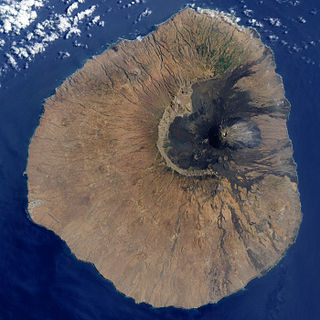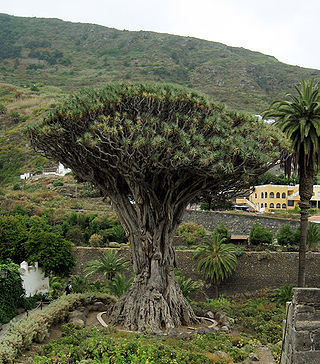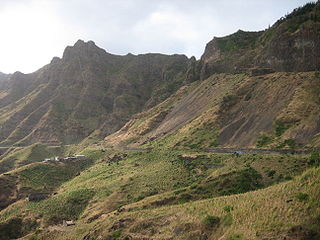
Macaronesia is a collection of four volcanic archipelagos in the North Atlantic, off the coasts of Africa and Europe. Each archipelago is made up of a number of Atlantic oceanic islands, which are formed by seamounts on the ocean floor whose peaks have risen above the ocean's surface. The Azores and Madeira archipelagos are part of Portugal, the Canary Islands are part of Spain, and the rest are part of the island country of Cape Verde. Politically, the islands belonging to Portugal and Spain are part of the European Union. Geologically, most of Macaronesia is part of the African tectonic plate. The Azores are located in the triple junction between the Eurasian, North American and African plates.

Socotra or Saqatri is an island of the Republic of Yemen in the Indian Ocean. Lying between the Guardafui Channel and the Arabian Sea and near major shipping routes, Socotra is the largest of the four islands in the Socotra archipelago. Since 2013, the archipelago has constituted the Socotra Governorate.

Fogo is an island in the Sotavento group of Cape Verde. Its population is 35,837 (2015), with an area of 476 km2. It reaches the highest altitude of all the islands in Cape Verde, rising to 2,829 metres above sea level at the summit of its active volcano, Pico do Fogo.

Dracaena draco, the Canary Islands dragon tree or drago, is a subtropical tree in the genus Dracaena, native to the Canary Islands, Cape Verde, Madeira, western Morocco, and possibly introduced into the Azores.

The Cape Verde national football team represents Cape Verde in men's international football, and is controlled by the Cape Verdean Football Federation. The team has never qualified for the FIFA World Cup, but has qualified for four Africa Cup of Nations tournaments, in 2013, 2015, 2021 and 2023.
Cape Verdean Americans are an ethnic group of Americans whose ancestors were Cape Verdean. In 2010, the American Community Survey stated that there were 95,003 Americans living in the US with Cape Verdean ancestors.

The Cape Verde Islands dry forests is a tropical and subtropical dry broadleaf forests ecoregion in the Cape Verde Islands, which constitute the country of Cabo Verde. The islands lie off the western coast of Africa.

Ehrharta is a genus of plants in the grass family.

Serra Malagueta is a mountain range located in the northern part of the island of Santiago, Cape Verde. At 1064 m elevation, it is highest point of northern Santiago. The mountain range is protected as the Serra Malagueta Natural Park, that was established on February 24, 2005 and covers 774 hectares. The natural park is situated in the municipalities Tarrafal, São Miguel and Santa Catarina. The summit is in São Miguel, south of the Ribeira Principal valley. The Serra Malagueta formation is of volcanic origin, and was formed between 2.9 and 2.4 million years ago.

The wildlife of Cape Verde is found across its archipelago of ten islands and three islets, albeit in smaller numbers of species than mainland Africa. Each volcanic island within the archipelago is unique, and each of them have parks under their jurisdiction, by decree promulgated by the Cape Verde government. Located just off the west coast of Africa, the total land area of the island nation is 4,564 square kilometres (1,762 sq mi).
With the exception of bats, there are no truly endemic species of mammal on Cabo Verde; historically, the archipelago was only accessible to creatures with the ability to fly or swim, or to be brought by humans. The islands were first explored in 1456, but not actually settled until 1462; humans brought their livestock with them, including donkeys, pigs, cattle and goats—many of the latter are now so wild, they resemble mainland ibex, and are considered endemic “by default”.
In the centuries since settlement began, more mainland species would make their way with waves of settlers. There are no snakes present on the archipelago, which has allowed for the proliferation of many other species of other herpetiles, such as geckos, frogs and lizards. The main predators of these reptiles and amphibians would be the various birds of prey and raptors present, including the Egyptian vulture, Eurasian buzzard, kestrel, osprey, peregrine falcon, and the rare Cape Verde kite. This kite species is currently threatened by extinction but may yet be observed on Boa Vista and Maio.

Melhania is a genus of small shrubs or herbaceous plants. Traditionally included in the family Sterculiaceae, it is included in the expanded Malvaceae in the APG and most subsequent systematics. The genus is named for Mount Melhan in Yemen.

Fagonia cretica is a species of plant in the caltrop family (Zygophyllaceae). It is native to dry regions of the Mediterranean Basin in North Africa, Southern Europe and West Asia.

Cape Verde or Cabo Verde, officially the Republic of Cabo Verde, is an archipelago and island country of West Africa in the central Atlantic Ocean, consisting of ten volcanic islands with a combined land area of about 4,033 square kilometres (1,557 sq mi). These islands lie between 600 and 850 kilometres west of Cap-Vert, the westernmost point of continental Africa. The Cape Verde islands form part of the Macaronesia ecoregion, along with the Azores, the Canary Islands, Madeira, and the Savage Isles.

Fogo Natural Park, on the island of Fogo, is one of ten "natural parks" in the country of Cape Verde. The protected area is 84.69 km2 (32.70 sq mi), which is 17.8% of the total area of the island. 50% of the park lies within the municipality Santa Catarina do Fogo, 28% in municipality of Mosteiros and 22% in São Filipe. The natural park is situated in the interior of the island, and covers the volcano Pico do Fogo, its crater and crater rim (Bordeira) and the forest of Monte Velha. The volcano is active; the most recent eruption was in 2014-15.

Héldon Augusto Almeida Ramos, known simply as Héldon and sometimes nicknamed Nhuck, is a Cape Verdean professional footballer who plays as an attacking midfielder.
Admilson Estaline Dias de Barros, known as Gegé, is a Cape Verdean professional footballer who plays as a central defender.
Exormotheca martins-loussaoae is a species of liverwort in the family Exormothecaceae, endemic to Cabo Verde.













